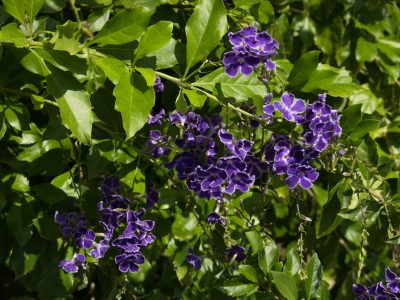Duranta

This rapidly growing shrub can get 10 to 15 feet tall and over 5 feet wide. It’s listed as hardy to only zone 9, so here in Central Texas, it dies to the ground in winter in most gardens.
But in our demonstration garden at the Extension office, Duranta is evergreen, hardly even skipping a bit in the coldest of winters. We have it planted against a wall, with full sun exposure all day, so the heat that builds up during the day is radiated during the night, keeping the microclimate much warmer there than in other areas of the garden. If Duranta dies to the ground in winter in your garden, simply prune it back to about 3 inches from the ground and it will reemerge from the roots in spring.
There are several cultivars of Duranta, but my favorite is the purple-flowering one. It flowers from early spring all the way through fall and doesn’t bat an eyelash at heat or the lack of rainfall. We also have a white flowering cultivar in our garden, and it’s also very pretty, and forms more pretty yellow, ball-like fruits than other cultivars.
If you want to attract native birds to your landscape, they’ll love the fruit of the white-flowering cultivar. Duranta will perform best in full sun, but can take light shade.
To do in your garden this week, it’s time to dead-head all of those spent blooms on your flowering plants, to encourage a second flush of color for the summer. If you have blackberries and have harvested all of the fruit, tip-prune the canes back to about 4 feet to promote branching, and thus a heavier fruit crop next season.
categories:
